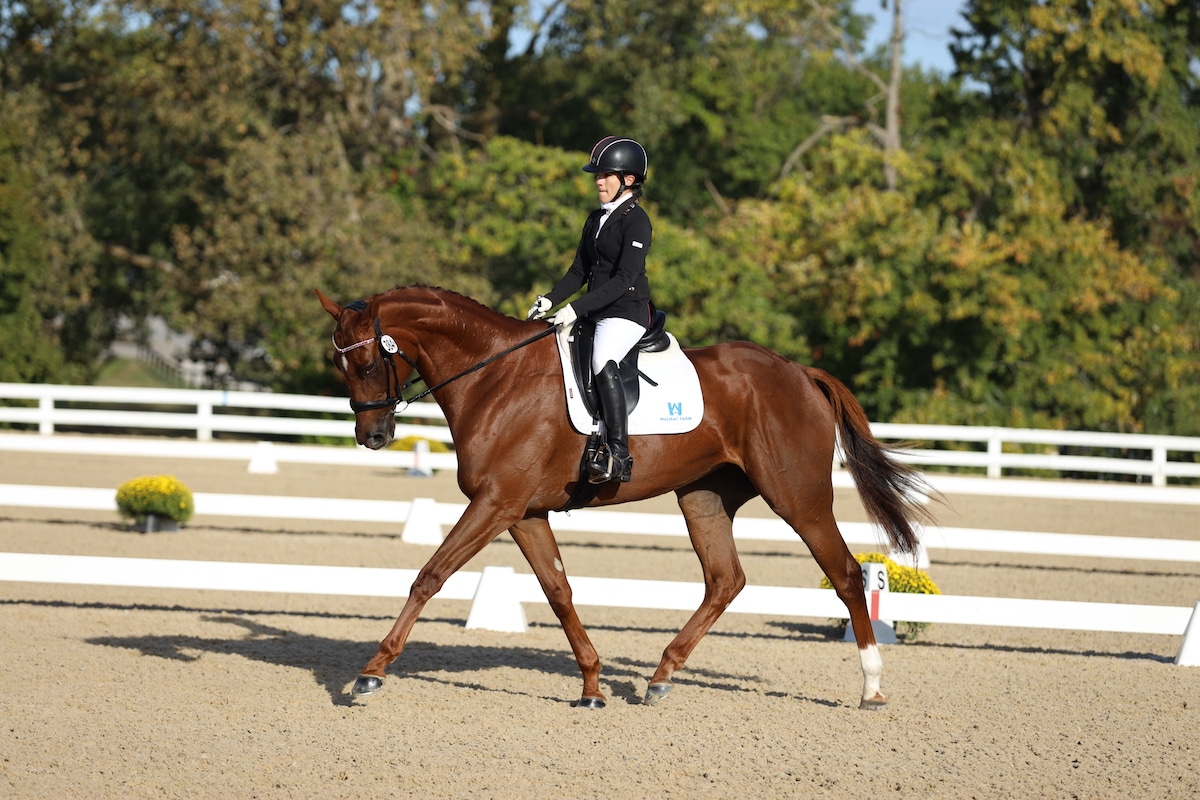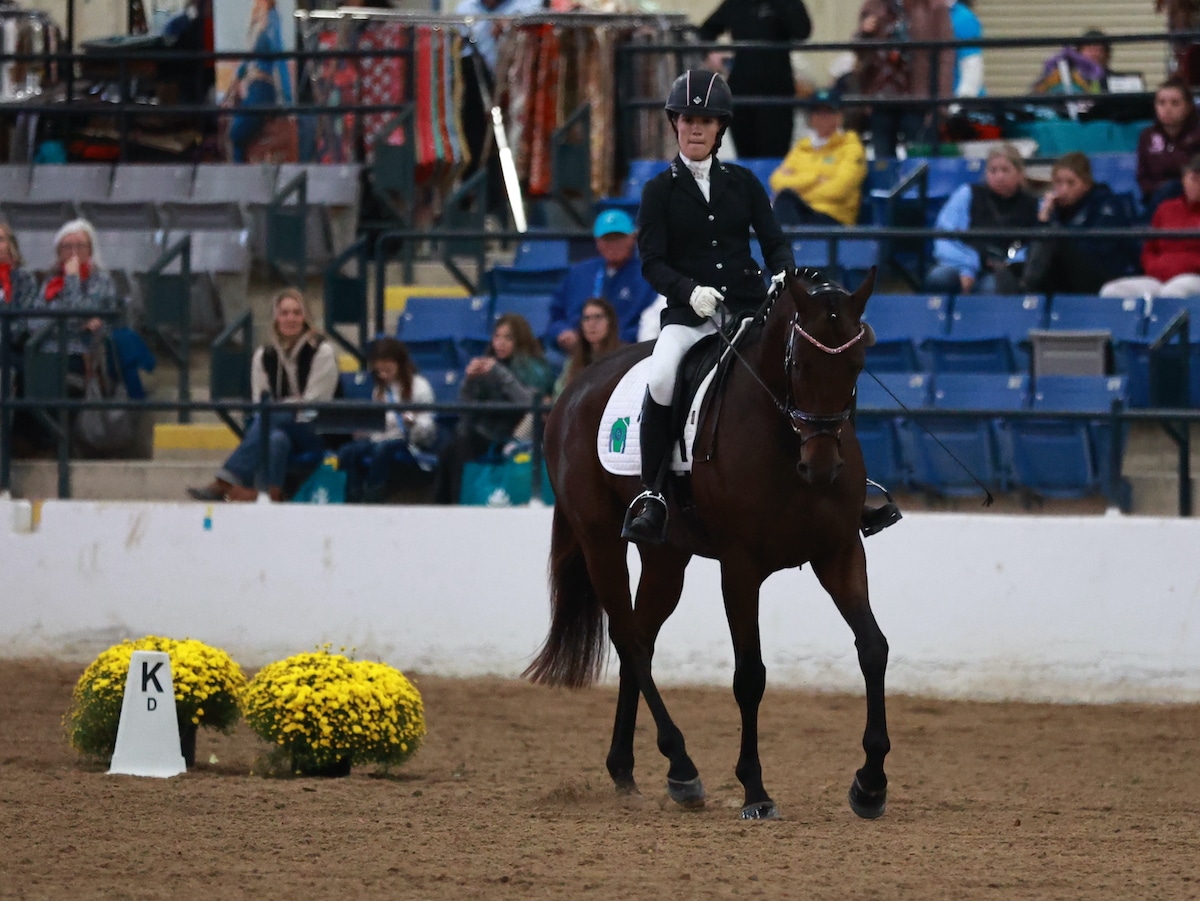
Alison O’Dwyer and 2023 Dressage top 20 Ratajkowski. Photo by Morgan Hampton
Q: How do you introduce lateral work in a green Thoroughbred?
A: Lateral work isn’t typically a part of most Thoroughbreds’ training when they’re on the track, but it’s a critical step in developing them for second careers. When starting a green Thoroughbred for that second career, the basics of flatwork and lateral work will be the foundation of all that is to come in any discipline: steering, stopping, slowing down or speeding up, and moving off of pressure in multiple directions. This is my typical process for introducing the basics.
If I have no information or experience with the horse previously, I will typically throw it on the lunge as an opportunity to evaluate them. So much value can come from this as the first step. Firstly, is the horse levelheaded or is it galloping around like a lunatic? I am a careful person that wants as much information on a horse before swinging a leg over. Plus, we are talking about flat work and that can begin on the ground.
Once we establish a level of workability in the horse, we can move on to other evaluation points. Often racehorses struggle with being lunged to the right; I believe this is more due to them being uncomfortable having a human in their right eye. If you think about it, horses are always being held and led from the left side and having a handler on the offside can make them uneasy. This could be a small point to consider when working with any horse on the ground; having a balanced ambidextrous horse is a great asset. While on the lunge, it’s important to take note of the horse’s inclination to move forward as well.
Next, I would get on the horse in order to feel what I am working with. Step one while mounted is the same on the lunge: does the horse go forward off of pressure? Do they slow down and stop? Then I will take a light feel of the mouth and pick a side and use one leg with heel pressure in a pulsing fashion at the girth. I am now looking to see if the horse can move sideways. Initially I might accept any sideways motion, but fairly quickly I move on to establishing what I call the “shoulder button.” This is always initiated at the walk.
To paint a picture of the epitome of the shoulder button, that’s a turn on the haunches. A clean, still, turn on the haunches with a loop in the rein and no mouth contact is the ultimate shoulder button goal. This shows the horse understands that shoulder pressure positioned at the girth means moving the shoulder and nothing else. Often you will see me do this in warm up to make sure my horses’ button is clear and concise.
As I try to get the green horse to learn that I am specifically asking for just the shoulder to move and not the hip, I might slow the walk down and go onto a small circle. You can even abandon all equitation rules and physically put your heel in front of the girth on the shoulder to make your point clearer. Any sideways motion of the shoulder needs to be quickly rewarded and pressure released in order for the horse to learn what you are asking.
After playing with this in the tack sometimes only for a few minutes, I will get off and work on it on the ground. This can vary with the horse’s quickness in understanding. If the horse is giving good lateral steps in the saddle and seems familiar with the concept I might not get off. Riding the horse initially gives me the feeling I might miss from going straight to a ground exercise.
While on the ground I would probably use a small jumping bat at the shoulder to act as my leg. With the reins in one hand and the stick in the other I can use it gently on the shoulder I want to move over while keeping my eyes on the front legs looking for crossover. If any crossover is offered, I quickly release pressure and reward the horse.

Alison O’Dwyer and 2023 Thoroughbred Makeover Champion Knockemdown. Photo by Sarah Schaaf
I also want to state here that when I say “pressure,” I mean a pulsing moving pressure that increases incrementally with time. Horses react better to movement and change, putting your leg on and holding the pressure steady will offer much less of a reaction because it’s often the change in pressure horses acknowledge, not the pressure itself. If the horse is swinging the haunches and it becomes difficult to control them, you can stand the horse with its haunches on the rail, so it is less inclined to reverse backward and swing the hind end. Just be aware that the arena fence will add a level of pressure from behind so keep an eye out for any heightened anxiety.
Quick recognition of a positive reaction to pressure is key to a happy horse that’s capable of learning. If you’re not sure you can feel the correct crossover, I would recommend utilizing a second pair of eyes to get started. Horses often take to this easier on one side vs another and that’s perfectly normal. While riding, I don’t drill the “bad side;” I bounce back and forth evenly so the good side can help reinforce what I am asking. Eventually they will even out.
Once I feel like I have established some form of a walking turn on the haunches I will pick up the trot on a large circle or oval off the rail to help reinforce the bend. I will place my lower leg at the girth and start to lift my heel with pulsing pressure, often in step with my posting to guide the horses’ shoulder to the outside connection. It still might take a bit for the horse to connect the dots and returning to the walk occasionally as a reminder of what we are asking is often needed in the beginning.
Racehorses have a go button and it’s really big: it’s the whole side of their body and sometimes even in their mouth. When it comes to training them for dressage or any flat work, we need to shrink the go button down and place in lateral buttons. I focus on the shoulder first, specifically because it is the key to connection. When you hear “inside leg to outside rein” that only works if your horse knows how to go towards the outside rein and not directly forward. I never have to try to get a horse on the bit once I’ve established my shoulder button.
Once the shoulder button is established you can use it to continue training additional lateral work. Your horse will also be able to find thoroughness in their topline and connection into the bridle. You can adjust the pressure placement to gain bend through the ribcage, you can train leg yield and then shoulder-in.
Establishing a shoulder button should be a low pressure, low impact exercise that a horse of any age is able to manage. Break it down to the simplest form by understanding that our job as trainers is to continue training horses to move off pressure. From the moment a foal is being a halter broke it is being taught to respect and move off pressure. In my opinion, dressage is that concept at its greatest level.
Alison O’Dwyer has found her niche identifying and developing young Thoroughbreds for second careers, with a strong background in eventing and dressage. She has evented through the CCI*** level and earned her United States Dressage Federation (USDF) bronze medal. Self-described as “an eventer who loves dressage,” O’Dwyer has experienced success at the Makeover in both disciplines.

